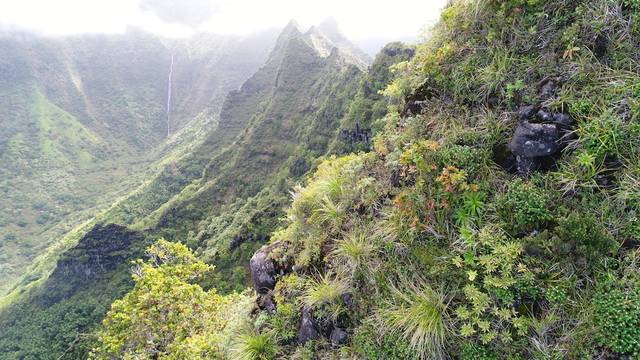Researchers are working a different take on reforestation at Kauai’s North Shore Limahuli Garden &Preserve, one that could restore the cultural connection and natural balance of native forests.
It’s an approach focused on the traditional relationship between the Hawaiian community and the forests versus simply looking to restore ecological health to the area.
And it could save money.
The concept is explored in a newly released paper authored by National Tropical Botanical Garden Kauai research associate Dr. Kawika Winter in collaboration with the University of Hawaii at Manoa.
The paper specifically looks at manager-defined ecological, hydrologic and cultural metrics of success, and long-term management costs and how they vary across different restoration strategies.
“These results can be used by conservation practitioners to guide management actions, and to bring the community back into the forest while improving multiple ecological and social benefits; and do all this at lower costs than programs focused solely on historical restoration goals,” said Winter, director of Limahuli Garden &Preserve in Haena.
More than 10 authors with social science and natural resource backgrounds worked on the paper, titled “Restoring to the Future: Environmental, Cultural and Management Tradeoffs in Historical versus Hybrid Restoration of a Highly Modified Ecosystem.”
They used NTBG’s Limahuli Garden &Preserve, which is a 400-hectare nature preserve in the ahupuaa of Haena. The preserve is the most biodiverse ecoregion in the Hawaiian archipelago, according to UH scholars, and researchers looked at various forests in different states of restoration — ranging from a pre-human state to a hybrid state that is made up of mixes of native and non-native species with cultural importance.
Researchers found that restoring forests to a hybrid state provided many of the same services that a restored “pre-human” state can provide, but at a much lower cost.
They also found hybrid reforestation increases cultural value and resilience to things like hurricanes and natural disasters.
“Restoring forests to a pre-human state on a landscape scale has been idealized, but given the amount of functional diversity that has gone extinct in Hawaii, such an approach is almost impossible, ecologically speaking,” Winter said. “Beyond that, our research has shown that goal is economically impractical, and it isn’t the best way to engage community in restoration efforts.”
Winter and other researchers say these methods also have applications far beyond Hawaii, especially in places with a history of cultural engagement with forests, where managers are faced with decisions on how to fund and approach restoration efforts.
“While conservation managers cannot make realistic decisions without considering costs, these types of tradeoff analyses are rare in restoration research,” said Dr. Kimberly Burnett, specialist with the UH Economic Research Organization, lead author of the study.
Burnett continued: “Our study provides a framework to consider these costs and benefits while providing specific management direction for Limahuli and generalizable lessons for restoration strategies around the world.”
The study was supported through a National Science Foundation grant to UH.
•••
Jessica Else, environment reporter, can be reached at 245-0452 or at jelse@thegardenisland.com.



